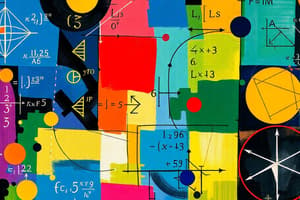Podcast
Questions and Answers
What do the letters in PEMDAS represent in the order of operations?
What do the letters in PEMDAS represent in the order of operations?
- Percentage, Exponents, Multiplication, Division, Addition, Subtraction
- Parentheses, Exponents, Modulus, Division, Addition, Subtraction
- Proportions, Exponents, Multiplication, Division, Addition, Summation
- Parentheses, Exponents, Multiplication, Division, Addition, Subtraction (correct)
Which of the following is NOT a basic operation in arithmetic?
Which of the following is NOT a basic operation in arithmetic?
- Exponentiation (correct)
- Multiplication
- Subtraction
- Addition
In statistics, what does the mode represent?
In statistics, what does the mode represent?
- The most frequently occurring value in a set (correct)
- The difference between the highest and the lowest values
- The middle value when arranged in order
- The average of a set of numbers
Which of the following best describes a prime number?
Which of the following best describes a prime number?
What is the purpose of a mathematical proof?
What is the purpose of a mathematical proof?
In calculus, what does a derivative measure?
In calculus, what does a derivative measure?
What is the primary focus of discrete mathematics?
What is the primary focus of discrete mathematics?
Which of the following describes the sine function in trigonometry?
Which of the following describes the sine function in trigonometry?
Flashcards are hidden until you start studying
Study Notes
Key Areas in Mathematics
-
Arithmetic
- Basic operations: Addition, Subtraction, Multiplication, Division.
- Order of operations: PEMDAS (Parentheses, Exponents, Multiplication and Division, Addition and Subtraction).
-
Algebra
- Variables and constants: Symbols used to represent numbers.
- Equations: Mathematical statements that assert the equality of two expressions.
- Functions: Relationships between inputs and outputs, often represented as f(x).
-
Geometry
- Shapes: Basic figures (e.g., triangles, squares, circles).
- Properties: Area, perimeter, volume calculations.
- Theorems: Pythagorean theorem, properties of angles.
-
Trigonometry
- Ratios: Sine, cosine, tangent.
- Applications: Solving triangles, periodic functions.
- The unit circle: A circle with a radius of one, used for defining trigonometric functions.
-
Calculus
- Limits: The value that a function approaches as the input approaches some value.
- Derivatives: Measure of how a function changes as its input changes.
- Integrals: Measure of the total accumulation of a quantity.
-
Statistics
- Data analysis: Mean, median, mode.
- Probability: The study of uncertainty and likelihood of events.
- Distributions: Normal distribution, binomial distribution, etc.
-
Discrete Mathematics
- Combinatorics: The study of counting and arrangement.
- Graph theory: Study of graphs and networks.
- Logic: Propositional and predicate logic.
-
Number Theory
- Prime numbers: Natural numbers greater than 1 that have no divisors other than 1 and themselves.
- Divisibility rules: Guidelines for determining if one number is divisible by another.
- Modular arithmetic: A system of arithmetic for integers, where numbers wrap around after reaching a certain value.
-
Mathematical Proofs
- Types of proofs: Direct, indirect, contradiction, and induction.
- Importance: Establishes the validity of mathematical statements.
Fundamental Concepts
- Set Theory: Study of collections of objects, including unions, intersections, and complements.
- Logic: Foundations of mathematical reasoning and structure.
- Mathematical Modeling: Using mathematics to represent real-world situations.
Problem-Solving Strategies
- Understanding the problem: Read carefully and identify what is being asked.
- Making a plan: Choose appropriate mathematical tools and methods.
- Solving: Carry out the plan step-by-step.
- Reflecting: Review the solution and verify it against the original problem.
Key Areas in Mathematics
- Arithmetic: Involves basic operations such as addition, subtraction, multiplication, and division, following the order of operations known as PEMDAS (Parentheses, Exponents, Multiplication and Division, Addition and Subtraction).
- Algebra: Utilizes variables (symbols for numbers) and constants to form equations, which are statements of equality between two expressions. Functions describe relationships between inputs and outputs, typically denoted as f(x).
- Geometry: Concerns various shapes (triangles, squares, circles) and their properties, including calculations for area, perimeter, and volume. Important theorems include the Pythagorean theorem and principles related to angles.
- Trigonometry: Deals with ratios like sine, cosine, and tangent, and applies these concepts to solve triangles and explore periodic functions. The unit circle, with a radius of one, is essential for defining trigonometric functions.
- Calculus: Focuses on limits (the value a function approaches with variable input), derivatives (how a function changes with input adjustments), and integrals (total accumulation of a quantity over an interval).
- Statistics: Covers data analysis with measures such as mean, median, and mode. Probability explores uncertainty and event likelihood, while distributions include concepts like normal and binomial distributions.
- Discrete Mathematics: Involves combinatorics (counting and arrangement), graph theory (study of graphs and networks), and logic (including propositional and predicate logic).
- Number Theory: Explores prime numbers (natural numbers with no divisors apart from 1 and themselves), divisibility rules for determining factors, and modular arithmetic which focuses on integers and cyclical properties.
- Mathematical Proofs: Encompasses various proof types such as direct, indirect, contradiction, and induction. Proofs validate the truth of mathematical statements.
Fundamental Concepts
- Set Theory: Analyzes collections of objects, emphasizing operations like unions, intersections, and complements.
- Logic: Forms the foundation of mathematical reasoning, establishing principles for valid arguments.
- Mathematical Modeling: Utilizes mathematical techniques to accurately represent real-world scenarios.
Problem-Solving Strategies
- Understanding the Problem: Read and interpret the problem carefully to determine the objective.
- Making a Plan: Select suitable mathematical tools and methods for addressing the problem.
- Solving: Execute the plan methodically, step-by-step.
- Reflecting: Review the final solution to ensure it aligns with the original problem's requirements.
Studying That Suits You
Use AI to generate personalized quizzes and flashcards to suit your learning preferences.




